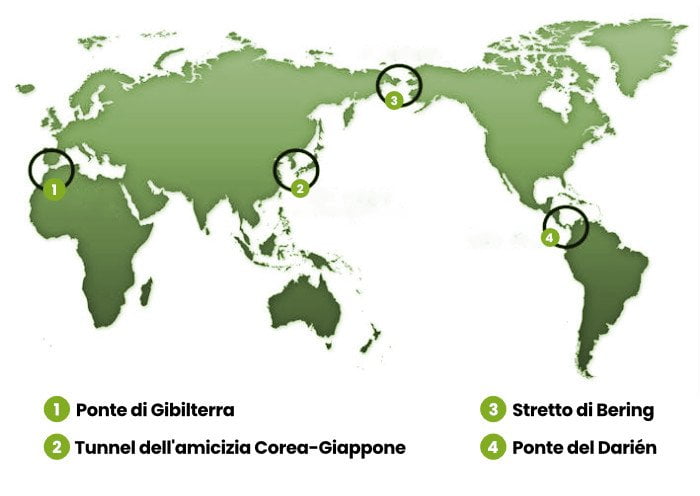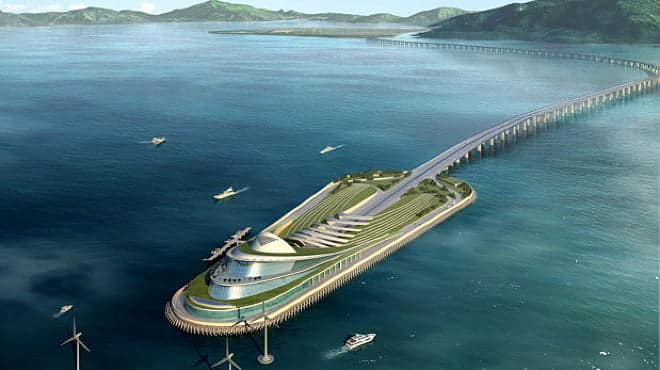On 24 October 2018 one of the world's most important bridges of the future saw the light: the Hong Kong-Zhuhai-Macau, 55 kilometers of bridges, underwater tunnel and four artificial islands.
9 years of work, 18 billion euros, guaranteed duration of at least 120 years and different qualities:
- It can withstand an 8.0 magnitude earthquake and a collision with a super cargo ship;
- Cut travel times from 3 hours to 30 minutes;
- The drivers' heart and pressure are monitored all the way: information is sent to the bridge control center;
- If a driver yawns more than 3 times in 20 seconds, a special camera goes on alert.
- The entire system is designed (and structured) to exploit 5G.
It is the last in order of time, but the first of next megaprojects that will redefine the world as we know it.
4 bridges of the future

Our engineering skills grow year after year. New methods, new materials, new ways of calculating will allow us to obtain results never possible even just a few years ago. Among the major challenges that are currently being planned, four bridges of the future in particular will have a monumental strategic importance.
Bridge over the Bering Strait

Building a system of bridges and tunnels across the Bering Strait can exponentially accelerate trade between North America and Asia. Difficulties in building the course will be offset by enormous benefits. Narrow width of bering? 83 kilometers.
The route under study that at this moment seems the most probable for the Bering Canal is the one that connects the Chukotka Peninsula in Russia and the Seward Peninsula in Alaska: exactly halfway, as a point of support, the Diomede Islands.
The basic idea of building this close connection between Siberia and Alaska (40km in total, but crucial) dates back to 1890, when William Gilpin, the first governor of Colorado, proposed it. In that case it was part of a larger project, a sort of "global railway" that would connect all the world's cities. One stage, the most important, would have passed right next to the frozen Bering Strait. Siberia to Alaska, so to speak.
Two years later Joseph Strauss, who already had over 400 bridge projects under his belt (and the role of project manager of the Golden Gate in San Francisco) made his proposal to the government of the Soviet Empire, but it was rejected. The fear was linked above all to the economic aspects: connecting all the small islands between Alaska and Siberia would have been like crossing the Bering Strait by asphalting it in width and length with a cement mixer. Impossible. Then the layout changed.
When in 1905 the Russian Tsar Nicholas II finally approved the project, the Russian revolution and the First World War put everything back in the drawer.
In recent years, other proposals have arisen, including a futuristic and ambitious line of fast trains from Manchuria to the United States (almost 10.000 kilometers!) Which would include an underwater part right under the Bering Strait.
Obstacles
The Russian side of the Strait lacks embarrassing infrastructure. The district of Siberia is a real frozen desert: for 3000 km there are no railways, and the first road (unpaved) is 1900 km away. However, in 2008 Vladimir Putin approved a plan to build a railroad that will reach the Strait by 2030.
On the American side, Alaska is also a large state with few roads: you need about 1200 kilometers of them. The nearest major city is Nome, with only 3500 inhabitants, 160 kilometers from the Strait. There are no means of communication between Nome and other cities.
Costs: the most substantial rumor that slows down the "Bering tunnel", one of the most interesting bridges of the future, is this. To complete it, given the difficulties, between 60 and 90 billion euros will be needed.
Bridge of the Darién

In 1937, North America and South America signed the Pan-American Highway Convention, an agreement to build a connection between the cities of member countries. For the next twenty years, an elaborate road system was built, but not completed. The missing piece is a thin strip of about 80 kilometers connecting Panama to Colombia. That area is known as the Darién “hole”.
The entire highway now consists of 30.500 kilometers of roads that go from Alaska to Argentina: a mammoth work that is not complete due to that one missing piece, full of mountains and precipices.
Obstacles
The fauna: the emptiness of Dariém is rather impractical: dense jungles, impenetrable mountains and lethal fauna (snakes, cougars, crocodiles, caimans and spiders).
Drug: Many rulers are against opening a new channel because they fear offering an easy passage between the two Americas to drug traffickers.
Japan-Korea bridge

The underwater bridge between Japan and Korea is a project open some time ago for a connection of about 200 kilometers that passes above and below the Korean strait using the islands of Iki and Tsushima as intermediate points of support.
Also in this case the proposal is a long one: it dates back to 1917, and has gone through phases in which the departure was given for imminent others of total abandonment.
Obstacles
costs: Each of these bridges of the future, as you will have understood, costs a lot because it has problems to deal with: in this case the problem is the type of workmanship that must be developed. To build a section of bridge and tunnel that respects the specific geological conditions of that area, the cost estimate exceeds 90 billion euros, a figure that currently discourages both countries.
Gibraltar bridge
The image may mislead you: despite the small distance between the two sides, the construction of a bridge over the Strait of Gibraltar requires extremely sophisticated engineering skills. Strait of Gibraltar? Exactly 13 kilometers.

The Strait of Gibraltar separates Europe from Africa. A distance of only 14 and a half kilometers. Yet this small stretch of sea (ocean?) presents very tough challenges in terms of construction, design and material physics. The Gibraltar Strait Bridge aims to overcome them.
In 1979 the governments of Spain and Morocco established a committee to investigate the possibility of connecting the two continents. Over the years a number of projects have been proposed, and the governments of the two countries are very interested, but so far no concrete plans have been launched.
The final project would be 40 kilometers (including two parts on the mainland and the underwater connection) 300 meters below the ground, and would take 15 years to complete at a cost of between 10 and 25 billion euros.


